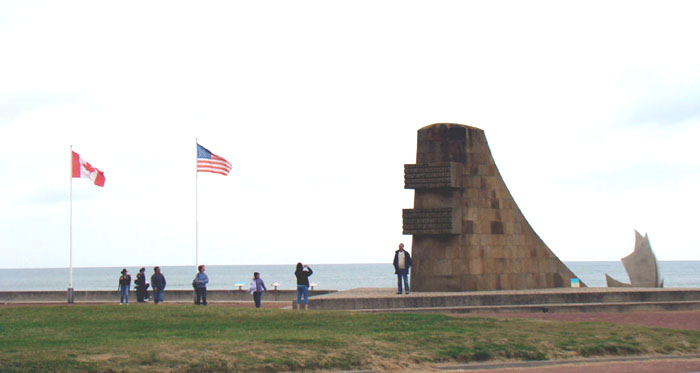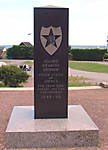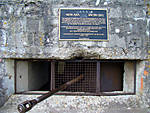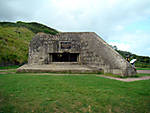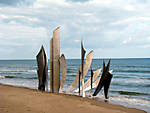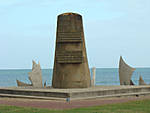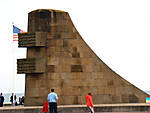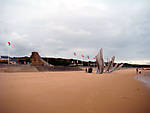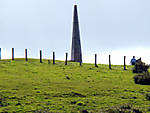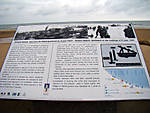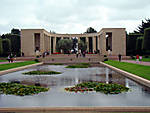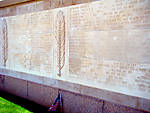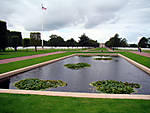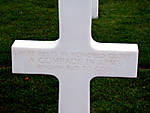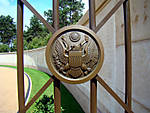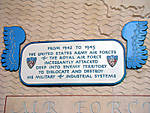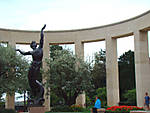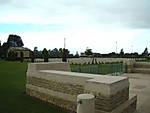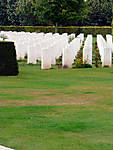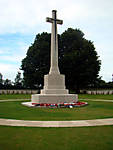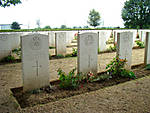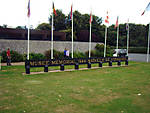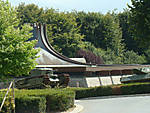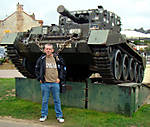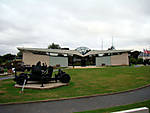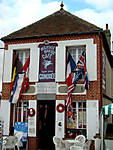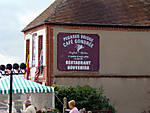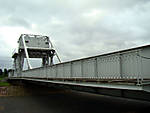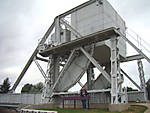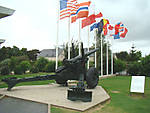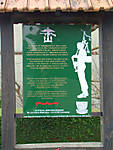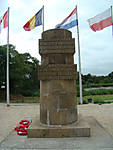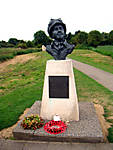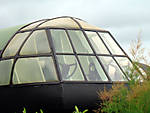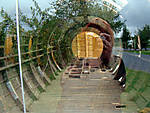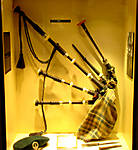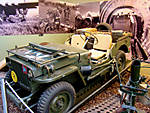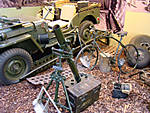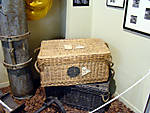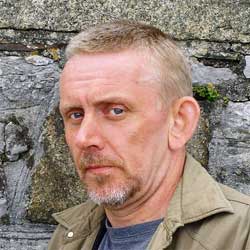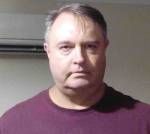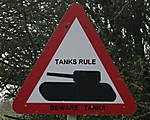1⁄1Postcard from Normandy
11
Comments
Bayeux to Saint-Laurent-Sur-Mer: Omaha Beach
The landings on Omaha are well-documented in many different sources. Although the fighting on the other beaches was fierce, that on Omaha was probably the worst on the morning of June 6. The nickname, 'Bloody Omaha', was well-given. Nowadays, the topography hasn't changed significantly and seeing the bluffs overlooking the beach, it's not too difficult to imagine how exposed the LZ must have been. The visitor center/museum is a short walk up the road from the seafront at Saint-Laurent-Sur-Mer. Many of the exhibits are presented in the form of full-size dioramas and several sections of the beach are reconstructed in this manner. There are quite a number of examples of the original beach defences one of the most interesting being the 'Belgian Gate' which was an underwater obstacle designed to rip the hull of landing craft (see photos). We walked along the beach from Saint-Laurent-Sur-Mer to Colleville-Sur-Mer which is a very interesting experience - being able to see how the beach changes from sand to pebbles and how the high-tide covers most of the beach. The latter area is where many of the troops were trapped and it's here where the breakthru was made when the engineers were able to blast a path through the dunes and off the beach. Later on, a road was constructed to move heavy equipment off the beach - this road is marked by the bunker (see photos) and a simple plinth commemorates the U.S. 2nd Infantry Division on the same spot. Omaha is still a very wild place. Although a number of holiday homes have been built between the bluffs and the beach one can still get the idea of what a claustrophobic area it must have been in 1944. Unlike other landing beaches, when the tide is in, there's little room. There is a certain 'pall' still hanging over the place. Despite from the many visitors who visit the area, it's very quiet and peaceful...Military cemeteries
We visited two of the many Military cemeteries of Normandy. While visiting Omaha, we visited the American Military Cemetery at Colleville-Sur-Mer. This is somewhat unusual as there are relatively few American military cemeteries outside of the U.S.A. For those who have visited the National Cemetery at Arlington Va., the similarities are immediately striking. The center point is a large semi-circular parthenon which overlooks a long pool (very similat to the Reflecting Pool in Washington D.C.). Within the Parthenon are relief maps of the Normandy campaign. The cemetery is the final resting place of 9,386 personnel with the names of another 1,557 inscribed on a wall in the Garden of the Missing. The location is very evocative as well, located on a hill which overlooks Omaha beach. The British Military Cemetery at Bayeux is on the outskirts of the town. For those that have visited other British/Commonwealth cemeteries before, virtually all are designed in the same manner. As with the American cemetery, this is also impeccably maintained. The cemetery contains 4,648 graves with the names of a further 1,801 whose remains were never recovered. There are many more cemeteries in Normandy inluding two Canadian ones and unusually enough, a Polish one at Urville-Langannerie.Away from the coast - other places of interest
The town of Bayeux is dominated by its enormous 12th century cathedral. Also in its own museum, as an interesting side-visit away from 20th century warfare, is the famous Bayeux Tapestry this documents another amphibious operation - the Norman Invasion of England in 1066. On the outskirts of Bayeux is a superb museum - Musée Memorial de la Bataille de Normandie (Memorial Museum of the battle of Normandy. In several large exhibition halls, the Landings and the following battle for Normandy. All aspects are extremely well-presented including the planning stages, the landings and the breakout from the area of the beaches. A good number of vehicles and an enormous amount of equipment is also well-displayed. Photos of some of the vehicles can be seen in my other Feature 'Armor in Normandy - Museums & Monuments'. Across the road from the museum is the British Military Cemetery of Bayeux. A few years ago, in Caen, the museum Le Mémorial de Caen was opened. This is probably the most grandiose of all the musems in Normandy and, sadly, in my opinion, the least focused. It is neither a museum to the Battle of Normandy nor, in the conventional sense, a museum of anything else. Rather it's a series of large exhibition areas which seem to have been designed with political-correctness in mind and the result is a hodge-podge of unrelated themes. The most interesting was probably the temporary exhibition of 9-11, the other exhibitions relied more on gimmickry than series academic presentation. Students of architecture will find much to enjoy, those of us with more 'conservative' tastes, less so. The saving grace to the museum is outside - the British and Canadian Memorial Gardens.Pegasus Bridge
Half-way between Caen and Ouistreham on the Orne River, is the bridge at Bénouville. On the night of the 5th/6th of June 1944, one of the most daring actions of the entire Normandy landings took place. A small glider force consisting of elements of "D" Company, 2nd Oxford & Bucks Light Infantry, attacked and succesfully seized the bridge. On the Eastern side of the river, is the museum Mémorial Pegasus. This, to my mind is one of the finest museums in the whole region. Covering everything from the Assault on the Bridge, the history of the 6th Airborne Division and as a sidebar, the use of glider-borne troops. It contains an absolute treasure-trove of incredible mementos of this incredible operation. Not least amongst them, is a set of bagpipes. These belonged to Piper Bill Millin of 1st Special Service Brigade, part of this unit, under the command of Lord Lovat, force-marched from their landing on Sword Beach to relieve the Glider force which a few hours earlier had taken the bridge at Bénouville. Millin, played the pipes as the relieving force crossed the bridge - under constant fire from the remnants of the German defenders. Outside the museum building is the ORIGINAL 'Pegasus Bridge' along with a full-size reproduction of a Horsa Glider. On the other side of the road are three concrete pillars marking the point where the Horsas landed along with a bust of Major John Howard, the commander of this operation. Another memorial plaque commemorates an unfortunate event - the death of Lieutenant Den Brotheridge, who was the first British soldier killed in action in Normandy. On the Western side of the bridge, is Café Gondrée which has the honor of being the first building liberated during the Normandy landings. However, the story doesn't end there. Thanks to information communicated to the Allies by the owners, the operation was helped considerably and thanks to the determination of the daughter of the cafe's owners, the museums at both Pegasus Bridge and that of the Battery of Merville were established as permament reminders.Final Thoughts
More than 60 years after the landings on the Normandy coast and the subsequent and bloody battles which finally allowed the Allies to move onwards towards the final defeat of Germany in the West, there are a few things worth considering. Firstly, the relatively short distances involved. If one travels from Caen to Ouistreham, the distance is something less than 20 kilometres. However, it wasn't until more than 6 weeks after the landings that Caen was finally liberated - after a tremendous cost in both civilian and military lives. In every churchyard in the region, apart from the usual memorials to the dead of WWI, there are many additional names of civilians who were summarily executed or sent to places whose names still bring horror to any civilized person - Auschwitz, Treblinka etc. There are still permament (and inadvertant) memorials to the ingenuity of the planning for Overlord - the remains of the Mulberry Harbors at Arromanches and, from the other side, the determination to foil any invasion - the dozens of overgrown bunkers which are still keeping watch on the coast. In the smaller memorials there is one which sticks in my mind, in a churchyard in a small village near Colleville-Sur-Mer. A tombstone commemorates the murder of a member of the French Resistance who was credited with having informed the Allies of the Scharnhorst leaving the port of Brest... It's no exaggeration to say that the whole region of Normandy is one living museum...
Acknowledgements
Many of the photos were taken by my wife - particularly those of the Mulberries. I'd also like to acknowledge her patience and forebearance particularly when it seemed as if we stopped at every plaque on every beach we visited. Next time we WILL visit Sainte-Mere Église!Comments
Great article. Im not an armour modeller but my uncle was in 7 para who fought at Pegasus Bridge so I've got a specific interest in this part of WW11. I've been lucky enough to visit Normandy twice and can back Jim up that the Pegasus Memorial Museum was by far the best I visited. If you’re going to visit Benouville I recommend visiting the Commonwealth War Cemetery at Ranville. This is a relatively small but beautifully looked after cemetery that is the resting place for most of the casualty’s of 6th Airborne and the commandoes. (It also has a number of German graves). Not only does it contain the grave of Lt Den Botheridge who was the first allied casualty of the war (he died in the attack on Pegasus Bridge) but also my uncle.
One point on Jims text though, and I don’t want to sound picky here but the Ox’s and Bucks were relieved not by the commandoes (who actually just passed through the paras) but were relieved by 7 Para at around 2.30 in the morning. The role of 7 Para is often forgotten completely or at best lightly touched (see Stephen Ambrose’s Pegasus Bridge) but most of the fighting to protect the bridge was undertaken by them. They fought off concerted attacks by the Germans who attacked in company strength backed by tanks and self propelled guns. Having lost their heavy mgs in the drop 7 Para (who could only muster half their strength at this point) fought off these attacks with nothing more than small arms and gammon bombs. At one point the battalion aid post was overrun and the wounded and Chaplin killed.
On one of my visits I was luck to be able to speak to Arlette Gondree who now runs the cafe at Benoville. She was very passionate about the role that 7 Para played in the battle and felt that their contribution had been long overlooked, in fact she went as far as to say that if weren’t for the paras the village would have been overrun and the villages "killed in their beds". Her words not mine.
Sorry about the length of the post but Imp proud of my uncle who was killed at 19 having given up a reserved occupation to fight.
SEP 06, 2008 - 08:16 AM
Jason, thanks for that post. No, you're correct. 7 Para are pretty much missing from any 'official' report on the action at Benouville. Unfortunately, that night, there was a lot of confusion and I think that Lovatt was given the credit (though not asking for it) - what your comments suggest is taht there should be another look at the 'official' histories..
I was 'taught' the operation while in the Terriers (T.A./ National Guard) and, I make no bones about it, I still consider it one of the greatest acheivements of Airborne Troops ever. I've been to Pegasus 4-5 times and every time I have to pause and think at just what an extraordinary operation was acheived that night. Even now, 60+ years afterwards, there's still an 'air' about the place...
SEP 06, 2008 - 12:38 PM
Great & informative article Jim.
Thank-you.
I'll be going to Normandy next June.
Paul
SEP 06, 2008 - 01:00 PM
Great article Jim ... one of the best for a long time. Its a refreshing change of pace from new kits and niggling over small details. I enjoyed looking through the pics and seeing these places of how it is today. Have never been there myself, but this article really makes me want to go. Hopefully some day!
SEP 06, 2008 - 01:43 PM
Very well done article Jim .
This article will be part of my guide for the trip o/seas for next year to slot inbetween Euro Miltaire.
The photo's taken by your wife certainly captures a serenity and moment to reflect of such a, how can I can I say ,world saving cause .
To be a related to a person who fought or served in this theatre should be very proud of their family achievements for what they have done .
SEP 06, 2008 - 04:43 PM
Here's the link for an abbreviated Unit history of 7th Parachute Battalion (part of 5th Para Brigade);
http://www.pegasusarchive.org/normandy/unit_5parabgd.htm
SEP 06, 2008 - 09:05 PM
Jim
Thanks for the comments. I can fully recommend the Pegasus archive website, it’s a great resource for anyone interested in the part of 6 airborne division in Normandy. Jim, I certainly think that the public perception of the battle for Pegasus bridge needs to be changed. When I first visited Benouville all I knew about battle came more or less from the Stephen Ambrose Book, Pegasus Bridge. However, following that conversation with Arlette Gondree, where she was quite forthright in her support of 7 Para I became interested in uncovering more on their role. I bought a small book in the museum called a Tale of Two Bridges which is the story of 7 para’s role in Normandy based on the diary of Col Pine-Coffin, the commander of 7 para along with contributions from other member of battalion published by Col Pine-Coffins son. I got in touch with the Pine-Coffin family, and thanks to his grandson, who is planning to publish a second book on the battalion I was able to find out more about my uncles time in the battalion. I also visited the records of the National Army Museum, the Airborne Museum at Aldershot and the National records office in Kew.
All that research showed that there was much more to the battle than presented in the Ambrose book. He doesn’t get things wrong more in concentrating almost exclusively on the glider troops has left out the contributions of the other units involved (and not just 7 Para). The book also suffers form being based primarily on the recollections of certain individuals who took part. However Ambrose did not allow those who contributed to view his manuscript before publishing and this lead in his own words to mistakes. He acknowledges this in the text of Band of Brother.
Once 7 para had arrived at the Bridges they became responsible for the defence and the Ox and Buck became attached to them, Major Howard passing over control to Pine-Coffin. He placed the glider troops in reserve in between the two bridges. The eastern end of the bridges, the river bridge was actually defended by a company of 12 Para. From then on the vast majority of fighting for the bridge was undertaken by 7 Para. That fighting would go on almost all and well beyond the arrival of the Commandoes. 7 Para would lose 70 men killed that day opposed to 3 by the initial glider coup-de-main, two of which were killed in the initial landing.
I was unaware that the planning of invasion assumed that the glider attack would fail and that the bridges would be blown. Both the Ox and Bucks and 7 para took folding boats with them and a platoon of the Para’s were specifically trained to use the boats to ferry troops across the river and canal. The 2nd Battalion the Warwickshire Regiment who were the actual troops to relieve 7 Para had been told that the bridge would be blown and to expect to have to fight for control of the western bank of the canal. Furthermore, the actual first troops to reach the bridges were not the Commandoes but there is evidence that it was a recce troop of engineers who were tasked to build a bailey bridge to replace the expected blown one (They are said to have arrived in a jeep and white scout car). This was actually built as the original bridge is narrow and wouldn’t have been able to cope with expected traffic across it.
There’s also evidence that a troop of sherman’s got into Benouville and disappeared along the Caen Road never to be seen again. You armour modellers might be interested to know that the “tank” described has having been knocked out by PIAT early on in the battle was probably a half track. This is described as having a small gun so may have been a 251 with a 37mm doorknocker. This seems reasonable as there was a german engineer unit in the area and would explain both the ease with which it was knocked out by the PIAT and why the remaining vehicles retreated so quickly. The armoured vehicles that were used in the attack on Benouville seems to have comprised a mix of Panzer 1V’s, Marders and what are described as French tanks, which I assume were Renaults.
Anway I could on like this for hours so will pack it in now. Please everybody if you’ve got some time read the 7 para history on the link that Jim sent or if your realy interested get hold of A tale of two bridges.
SEP 07, 2008 - 12:39 AM
Nice article Jim.
Myself and four Belgian friends (I am a Brit ex squaddie BTW) went to Normandy last year for 9 days (St M E to Caen), we had a great time. Very moving too, we also passed Arras on the way where my Great Grandfather is comemorated on the WWI memorial.
We did Ypres this year and its off to The Ardennes next year (we are doing that in Dec so we can fuffer some of the conditions those poor guys had to endure). I have a lot of pics and vids of Normandy (and Ypres and lots from wtaerloo) if anyone needs extra material.
Cheers
Sid
SEP 08, 2008 - 09:13 AM
Copyright ©2021 by Jim Rae. Images and/or videos also by copyright holder unless otherwise noted. The views and opinions expressed herein are solely the views and opinions of the authors and/or contributors to this Web site and do not necessarily represent the views and/or opinions of Armorama, KitMaker Network, or Silver Star Enterrpises. All rights reserved. Originally published on: 2008-09-22 00:00:00. Unique Reads: 18668




